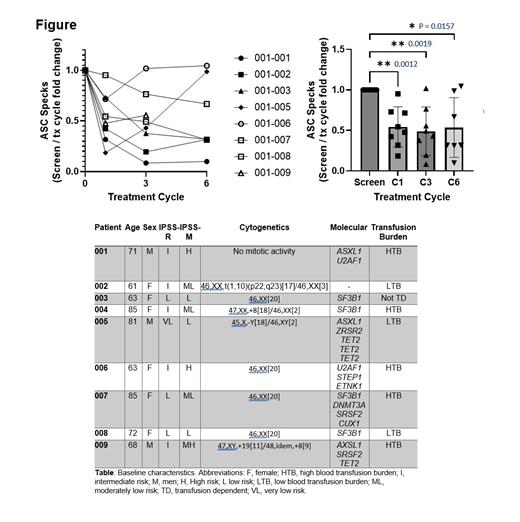Introduction: Pyroptosis is a form of inflammatory, caspase-1 dependent lytic cell death mediated by inflammasome activation and ultimately leading to enumeration of pro-inflammatory cytokines, particularly interleukin 1β (IL-1β) and is a key driver of MDS pathogenesis (Basiorka A, Blood 2016). Release of IL-1β by pyroptotic cells leads to paracrine stimulation of neighboring hematopoietic and stromal cells resulting in amplification of this circuit, myeloid derived suppressor cell (MDSC) accumulation as well as direct suppression of erythropoiesis. Thus, we investigated the combination of the IL-1β neutralizing antibody canakinumab in combination with darbepoetin in patients with ESA refractory lower risk MDS and present the final dose phase 1b data.
Methods: Patients ≥ 18 years old with IPSS-R very low to intermediate risk MDS who were ESA refractory and hypomethylating agent (HMA) naïve with adequate organ function were eligible. Patients must have been RBC transfusion dependent or hemoglobin < 9 gm/dl with symptoms. Treatment consisted of subcutaneous (SC) canakinumab on day 1 of a 28 cycle (150mg dose level 1, 300mg dose level 2) and darbepoetin SC 300µg days 1 and 15 of each cycle for a total of 6 cycles with continuation of therapy for responding patients. The phase 1b portion utilized a 3+3 dose escalation design with 6 patients treated at the maximum tolerated dose (MTD) to define the recommended phase 2 dose (RP2D). Bone marrow (BM) disease assessments occurred every 3 cycles with response defined by IWG 2018 criteria. Quality of life was assessed by QUALMS (Abel A, Haematologica, 2016). Peripheral blood mononuclear cells (PBMCs) were obtained at disease assessments and day 15 of C1 for evaluation of adapter protein apoptosis associated speck-like protein containing a CARD (ASC) specks as a biomarker of inflammasome formation with quantification as previously described (McLemore A, Pyroptosis: Methods and Protocols, 2023). Total IL-1β of BM plasma was assayed by ELISA.
Results: Nine patients enrolled with a median age of 71 (range: 61-85 years), 67% female with baseline IPSS-R, IPSS-M and mutation data shown in Table. By IPSS-M, 3, 3, 1, 2 patients were low, moderately-low, moderately high, and high-risk categories. All IPSS-M lower risk mutant patients had splicing mutations. The median number of mutations was 2 (range 0-5). 100% of patients were ESA refractory. Additionally, 33% and 56% were refractory to lenalidomide and luspatercept therapy, respectively. Eight (89%) patients were PRBC dependent at baseline (56% [n=5] with high transfusion burden).
The median follow-up duration was 6.1 months (range 3-17.8). The most common adverse events were neutropenia (n=7), followed by thrombocytopenia (n=4), and abnormal liver function tests (n=4). There were two grade 3 adverse events including thrombocytopenia and colitis, both unrelated to study treatment. There were no dose-limiting toxicities or serious adverse events in the phase 1 portion. All patients achieved the best response as stable disease, and no one had progression disease. No patients achieved objective response or significant reduction in transfusion burden. There was no statistical improvement in total QUALMS score from baseline to end of treatment (P=0.72) nor in the individual components (i.e. physical burden, benefit finding and emotional burden, P=0.69, P=0.91, P=0.630; respectively) although several patients had individual improvements.
The percentage of PBMCs with ASC specks at baseline ranged from 0.3945-2.978% (median 1.93%). ASC specks decreased significantly after cycle 1 of therapy and were durably suppressed over the course of treatment in a majority of patients (Figure). Extracellular IL-1β in bone marrow plasma robustly increased with treatment and remained elevated (representing non-functional IL-1β [canakinumab bound IL-1β]; P=0.002 cycle 6 versus baseline), supporting pharmacodynamic effect with no differences observed between DL1 and DL2.
Conclusions: The combination of canakinumab and darbepoetin was safe and well tolerated and 300mg of canakinumab is the RP2D. Canakinumab inhibited inflammasome activation as evidenced by a reduction of ASC specks although this did not translate to clinical responses. Phase 2 of the study will focus on patients with lower transfusion burden and molecular subsets with highest IL-1β expression (e.g. TET2/ DNMT3A mutant).
Disclosures
Sallman:AbbVie, Affimed Gmbh, Gilead, Incyte, Intellisphere, LLC, Molecular Partners AG, PGEN Therapeutics, Inc., Takeda, Zentalis; Advisory board for AvenCell, BlueBird Bio, BMS, Intellia, Jasper Therapeutics, Kite, Magenta Therapeutics, NKARTA, Novartis, Orbita: Consultancy; Aprea, Jazz: Research Funding. Kuykendall:BMS: Consultancy, Research Funding; Blueprint: Consultancy, Research Funding, Speakers Bureau; Protagonist Therapeutics, Inc.: Consultancy, Research Funding; Morphosys: Consultancy, Research Funding; Prelude: Research Funding; GSK: Consultancy; Imago: Consultancy; Incyte: Consultancy; AbbVie: Consultancy; Sierra Oncology: Research Funding; CTI: Consultancy; Novartis: Consultancy. Padron:Kura: Research Funding; Incyte: Research Funding; BMS: Research Funding; Pharmaessentia: Membership on an entity's Board of Directors or advisory committees; Abbvie: Membership on an entity's Board of Directors or advisory committees; CTI: Membership on an entity's Board of Directors or advisory committees; Gillead: Membership on an entity's Board of Directors or advisory committees. Lancet:Jazz: Consultancy; MD Anderson: Consultancy; Atheneum: Consultancy; BerGenBio / DAVA Oncology: Consultancy; Boxer Capital: Consultancy; Celgene: Consultancy, Research Funding; Globe Life Sciences: Consultancy; Jasper Therapeutics: Consultancy; AbbVie Inc.: Consultancy; MEDTalks: Consultancy; Novartis: Consultancy; Peer Voice: Consultancy; Servier: Consultancy; Tegus: Consultancy; The Dedham Group: Consultancy. Komrokji:Rigel, Taiho, DSI: Honoraria, Membership on an entity's Board of Directors or advisory committees; Geron: Consultancy; BMS: Honoraria, Membership on an entity's Board of Directors or advisory committees, Research Funding; Novartis: Membership on an entity's Board of Directors or advisory committees; AbbVie, CTI biopharma, Jazz, Pharma Essentia, Servio: Honoraria, Membership on an entity's Board of Directors or advisory committees, Speakers Bureau.


This feature is available to Subscribers Only
Sign In or Create an Account Close Modal